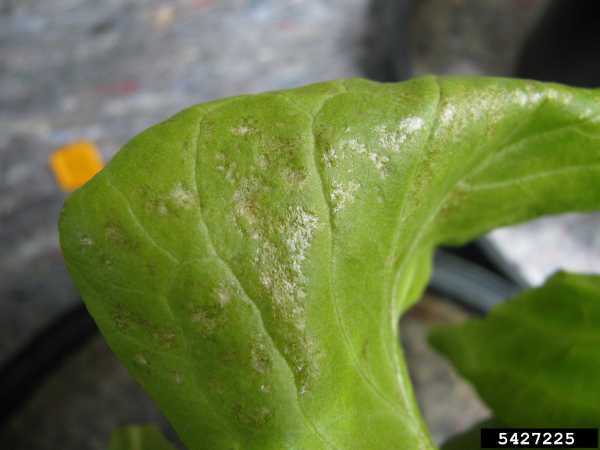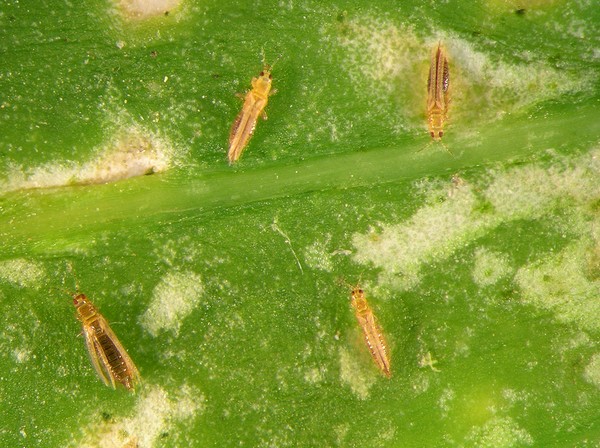
Thrips
Frankliniella Occidentalis
Pathogen:
Insect
Type:
Risk:
HIGH
Trips



WHO CAUSES IT?
Frankliniella occidentalis, known as western flower thrips, is a small insect that infests various crops, including lettuce. Adults measure between 1 and 2 mm and have an elongated body, usually yellow or brown. They have fringed wings that allow them to disperse easily. The female deposits her eggs within the plant tissues, where the larvae develop, which emerge after a few days. These larvae go through two larval stages before becoming nymphs, a stage in which they stop to pupate in the soil or at the base of plants. They then emerge as adults ready to feed on leaves, flowers and fruits. Thrips have a very rapid reproductive cycle under favorable conditions, which can cause explosive outbreaks in crops, especially in hot, dry climates.
SYMPTOMS
In lettuce, thrips feed by piercing the plant cells and sucking the contents, which causes the destruction of plant tissues and the appearance of scars on the leaves. This damage reduces the commercial quality of the lettuce and can make affected plants less attractive for sale. In addition to direct physical damage, thrips can also act as vectors for viruses, such as tomato wilt virus (TSWV), further exacerbating problems in the crop.
- Leaves with silvery or tan scars due to sap suction.
- Deformations in young leaves.
- Brown Taches on the leaves.
- Presence of black excrement on the underside of the leaves.
- Appearance of viruses such as TSWV transmitted by thrips.
- Loss of vigor in affected plants.
- Reduction in crop growth and quality.
TEMPERATURE AND HUMIDITY
20-30°C
40-60%
TRANSMISSION PATHS
Wind, movement of infested plants, contaminated growing tools, humans, migration of winged thrips
TREATMENTS
Chemical treatment
• ABAMECTIN 0.0015% + PYRETHRINS 0.02% [AL] P/V
• RAPE OIL 1.53% [AL] P/V
• RAPE OIL 848.24 g/l [EC] P/V
• ORANGE OIL 6% [SL] P/V
• ORANGE OIL 60g/L [ME] P/S
• AZADIRACTIN 1% (AS AZADIRACTIN A) [EC] P/V
• Azadirachtin 2.6% (AS AZADIRACTIN A) [EC] P/V
• CYANTRANILIPROL 10% + ACIBENZOLAR-S-METHYL 1.25% [SC] P/V
• CYANTRANILIPROL 20% [SC] P/V
• DELTAMETHRIN 1.5% [EW] P/V
• DELTAMETHRIN 1.57% [SC] P/V
• DELTAMETHRIN 10% [EC] P/V
• DELTAMETHRIN 2.5% [EC] P/V
• DELTAMETHRIN 2.5% [EW] P/V
• FORMETANATE 50% [SP] P/P
• LAMBDA CYHALOTHRIN 0.0015% [ME] P/V
• LAMBDA CYHALOTHRIN 1.5% [CS] P/V
• LAMBDA CYHALOTHRIN 10% [CS] P/V
• PYRETHRINS 4% (PYRETHHRINE EXTR.) [EC] P/V
• POTASSIUM SALTS OF FATTY ACIDS C14-C20 48% [EW] P/V
• SPINETORAM 2.5% [SC] P/V
• SPINOSAD 2.4% [SC] P/V
• SPINOSAD 48% [SC] P/V
• SPIROTETRAMAT 10% [SC] P/V
• SPIROTETRAMAT 15% [OD] P/V
• TAU-FLUVALINATE 24% [EW] P/V
Authorized treatments in organic farming
• RAPE OIL 1.53% [AL] P/V
• RAPE OIL 848.24 g/l [EC] P/V
• ORANGE OIL 6% [SL] P/V
• ORANGE OIL 60g/L [ME] P/S
• AZADIRACTIN 1% (AS AZADIRACTIN A) [EC] P/V
• Azadirachtin 2.6% (AS AZADIRACTIN A) [EC] P/V
• LAMBDA CYHALOTHRIN 0.0015% [ME] P/V
• LAMBDA CYHALOTHRIN 1.5% [CS] P/V
• LAMBDA CYHALOTHRIN 10% [CS] P/V
• PYRETHRINS 4% (PYRETHHRINE EXTR.) [EC] P/V
• POTASSIUM SALTS OF FATTY ACIDS C14-C20 48% [EW] P/V
• SPINOSAD 2.4% [SC] P/V
• SPINOSAD 48% [SC] P/V
Traitements biologiques
• AMBLYDROMALUS LIMONICUS (Parasitoid and predatory mites)
• AMBLYSEIUS SWIRSKII (Parasitoid and predatory mites)
• BEAUVERIA BASSIANA (STRAIN ATCC 74040) 2.3% (2.3X10E7 VIABLE SPORES/ML) [OD] P/V
• BEAUVERIA BASSIANA (GHA STRAIN) 22% (4.4 x 10E10 CONIDIAS/G) [WP] P/P
• BEAUVERIA BASSIANA strain PPRI 5339 8% (8 X 10E12 CFU/L) [OD] P/P
• CHRYSOPERLA CARNEA (Parasitoid and predatory insects)
• HETERORHABDITIS BACTERIOPHORA (Parasitoid and predatory nematodes)
• MACROCHELES ROBUSTULUS (Parasitoid and predatory mites)
• MACROLOPHUS PYGMAEUS (Parasitoid and predatory insects)
• METARHIZIUM BRUNNEUM strain Ma 43 10.5% [OD] P/V
• NEOSEIULUS CUCUMERIS (Parasitoid and predatory mites)
• ORIUS LAEVIGATUS (Parasitoid and predatory insects)
• PAECILOMYCES FUMOSOROSEUS (STRAIN FE 9901) 18% (2 X 10 E9 CFU/G) [WP] P/P
• STEINERNEMA FELTIAE (Parasitoid and predatory nematodes)
• TRANSEIUS MONTDORIENSIS (Parasitoid and predatory mites)
Recommendations
- Implement physical barriers, such as anti-insect mesh, to prevent thrips from entering the crop.
- Carry out periodic inspections in the initial stages of lettuce growth to detect the early presence of thrips and apply control measures immediately.
- Promote biological control by introducing natural predators of thrips, such as predatory mites (*Amblyseius swirskii*) or insects such as lacewing.
- Avoid excessive use of broad-spectrum insecticides that can eliminate the natural enemies of thrips and cause imbalances in the crop ecosystem.
- Use blue sticky traps to monitor the thrips population and detect early infestations.
- Rotate crops to break the life cycle of thrips and reduce the incidence of infestations in successive seasons.
- Apply specific phytosanitary treatments for thrips at critical moments, ensuring that different modes of action alternate to prevent the appearance of resistance.
- Maintain good ventilation and humidity control in greenhouses, since dry conditions favor the development of thrips.
TREATMENTS
Homemade treatments
- There are no home treatments
Natural allies
Chemical treatments
- There are no treatments for this disease. Treatments are directed at the insect vectors that transmit it. See insect treatments.
RECOMMENDATIONS
- Check the back of the leaves frequently, especially in dry weather.
- Spray water on the leaves to increase humidity and prevent them from settling.
- Keep plants healthy with good watering and adequate light.
- If you see cobwebs or damage, clean the leaves with a damp cloth or pressurized water.
- Use potassium soap or neem oil every few days until they disappear.
REPELLENT PLANTS
Rosemary, Dill, Coriander
RECOMMENDED PRODUCTS
*The recommended treatments are still recommendations according to the databases of the authorities and at no time do they replace the guidelines established according to the legislation of each country
*The products shown are recommendations and are not our own products. As Amazon Associates, we earn revenue from purchases of recommended products.





















